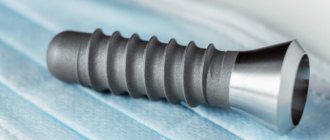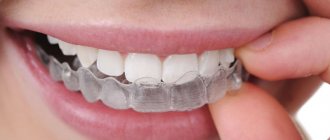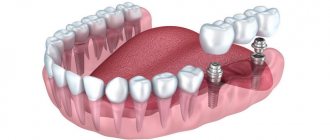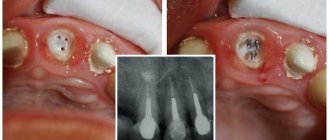A modern method of restoring dentition – dental implantation – involves inserting an artificial root into the jaw bones. The procedure is performed surgically. When traumatic tissue damage occurs, a natural pain syndrome occurs. Based on this, many patients wonder: Does it hurt to get dental implants?
or do modern dentistry have effective methods for painlessly introducing titanium structures into living tissues?
In the article we will talk about the patient’s feelings at each stage of implantation, consider the types of dental implants, descriptions, advantages
designs.
Dental implantation - does it hurt?
Is it painful or not to insert a dental implant? Many patients are interested. The answer is no, since the operation is performed under anesthesia. Types of anesthesia used in dentistry:
- Local - an injection is given, after which the sensitivity of the area disappears for the duration of the operation. The gums are “frozen”, and the bone tissues are not susceptible to pain.
- Anxiolysis is minimal sedation with a calming effect, the patient ceases to be afraid of the procedure.
- Moderate sedation - the patient is completely relaxed, but still conscious.
- Oversedation is a state of half-asleep.
- General anesthesia is rarely used. Indications: gag reflex, allergies to local anesthesia, mental disorders. Performed during extensive operations - bone grafting, installation of more than 10 implants.
In our Center, we offer the patient light sedation; the patient in this state does not feel pain, does not worry, and calmly responds to the doctor’s requests.
How can you reduce fear and anxiety before implantation?
If a patient, despite everything, experiences a lot of stress before surgery to install a dental implant, the dentist can help him with this too. Premedication is used to reduce anxiety, ease fears and reduce anxiety. This is a course of sedatives. The patient takes them shortly before the date for which implantation is scheduled.
In addition, sedation can be performed simultaneously with local anesthesia. This is the name given to the administration of drugs that, depending on the dose:
- have a slight calming effect on the patient, relieve emotional stress;
- completely relax a person, but he remains conscious;
- immerse the body in a state of half-asleep, between sleep and reality.
Anesthesia (general anesthesia) when installing implants is used less frequently and only according to indications determined by the dentist.
How to install implants
Anesthesia is performed only during surgical interventions. Prosthetics is a painless procedure. The implantation process consists of several stages:
First surgical – implant installation
The procedure begins with anesthesia. The patient is injected with an anesthetic into the area where the artificial root is installed. If the operation is performed under sedation, the anesthesiologist will first administer a sedative intravenously. The gum is peeled off, and a bed for an artificial root is created in the bone using special instruments. The implant is inserted into the prepared hole, a plug is fixed on top, and the tissue is sutured. The operation lasts 15-30 minutes. The anesthesiologist brings the patient out of a half-asleep state, after 20-30 minutes the patient can move independently, even drive a car. The next appointment is scheduled in 10 days to remove the stitches. The implant takes 2-4 months to take root in the lower jaw and up to six months in the upper jaw.
The second surgical stage is the installation of a gum former
After engraftment with the jaw bone, the implant is opened, the plug is removed, and a former is inserted. The procedure is performed under local anesthesia and lasts no more than 10 minutes. The former is installed for 10-14 days to create an even gingival contour.
Prosthetics
This stage is completely painless, because... no tissue incisions are required. The former is replaced by an abutment that connects the implant and the prosthesis. A crown is installed on it, made from previously taken impressions.
Why is there no pain when installing an implant in the jawbone?
People wonder whether it hurts to get a dental implant because they have little idea about the process. You’ve heard something about “cutting the gums, drilling out the bone,” and with a rich imagination, they paint frightening pictures in their minds.
Naturally, treatment at the dentist cannot be called pleasant; this is not a relaxing massage session. Discomfort is possible, since even lying in the dental chair for a long time with your mouth open is unpleasant. But with standard implant installation, you have to stay in this position for only a short time – 15–20 minutes. And there is no pain at all, only slight pressure and vibration are felt.
To eliminate pain when inserting a dental implant into bone tissue, the dentist selects the optimal type of anesthesia for a particular situation. In most cases, this is local anesthesia, in which the doctor injects an anesthetic into the area of the upcoming operation. The injections are easily tolerated and you should not be afraid of them. After the administration of the anesthetic, the operated area completely loses sensitivity, so the person does not feel any pain when installing the implant.
The doctor’s opinion is that the operation itself is completely painless
Before installing a dental implant, patients often worry about the procedure and how they feel in the dentist’s chair. But there is no discomfort at all; the patient can only feel slight pressure or vibration. If we compare the procedure with tooth extraction, the latter feels much more unpleasant. For anxious patients, you can take a course of premedication before surgery.
Levin Dmitry Valerievich
Chief physician, Ph.D.
Does it hurt to get a crown?
Doctors Works
Among the methods of prosthetics for one missing tooth, a crown remains the most popular solution. However, many patients who are indicated for such prosthetics are interested in the question of whether it is painful to install a crown, and how much time is needed for this procedure?
- Alekperov R.B. Orthopedic dentist
Question:
My upper third tooth was badly damaged. I definitely don’t want to remove it, but I’m afraid that putting a crown will also hurt. There is a living nerve inside.
Answer:
Absolutely all procedures performed in ROOTT dentistry are painless: from the installation of crowns to implantation using an effective local anesthetic.
- Alekperov R.B. Orthopedic dentist
Question:
I want to put a crown on a broken tooth (bottom 4). What difference does it feel if you use metal ceramics or zirconium?
Answer:
Zirconium crowns offer the possibility of removing a smaller layer of enamel during preparation. This means that in most cases the nerve can be saved. For metal ceramics, you need to remove more enamel, since the crown itself is “thicker” (otherwise, an overly thin layer of ceramics will not hide the metal base).
< Previous Next >
A crown is a popular method of replacing a single lost tooth.
It is installed painlessly, and discomfort is associated with preparation for prosthetics. At the initial stage, endodontic treatment is carried out:
- filling the canals,
- eliminate caries, pulpitis or other disease that led to the destruction of the coronal part.
In parallel, the type of crowns (material) is agreed upon with the patient. Popular types:
- Metal-plastic - inexpensive. Used as a temporary solution. The service life is 3-5 years.
- Metal-ceramic - based on the “classic” cobalt-chrome alloy, gold or other precious metals.
- Zirconium dioxide is an option characterized by aesthetics and durability. An effective solution if it is necessary to restore the anterior dental element, as it recreates the color and natural gradient transparency.
The tooth preparation stage involves preparation to give a shape reminiscent of the outline of a “living” dental element, but of smaller volume. After this, the cap will “sit” on the stump.
When preparing innervated teeth, the patient will not feel any discomfort. If the dental element has nerves, then local anesthesia is given before the procedure. After grinding, an impression is taken from the stump and a crown is made. If production is expected to take place over several days, a light plastic cap is installed so that the ground tooth is less exposed to food and saliva.
While the patient is puzzled by the question of whether it hurts to put crowns and puts off going to the orthopedic dentist, the situation with the teeth worsens, and in the end there will be nothing to use prosthetics.
Expert of the article Alekperov Roman Borisovich Dentist-orthopedist, doctor of the first category
Work experience24 years
How long does pain last after implantation?
Getting a dental implant does not hurt. But after the end of the anesthesia, discomfort will be felt; this is a normal reaction to the intervention. On average, it lasts 1-3 days, the intensity and duration depends on the volume of the operation and the number of artificial roots installed. The nature of the pain can be sharp, diffuse, shooting, pressing, aching or cutting. Other body reactions are within normal limits:
- itching;
- edema;
- compression of tissues and muscles.
Is it painful during surgery?
Bone grafting during dental implantation is a preliminary stage of prosthetics. Artificial jaw augmentation is necessary for the successful installation of artificial roots of incisors and molars, on which crowns are then placed. The reliability of the screws increases the durability of the entire structure. To prevent pain for the patient, local anesthesia is used. The doctor selects a drug that completely eliminates the sensitivity of tissues in the intervention area and the required dose of anesthetic.
An experienced surgeon will analyze the chemical composition of the drug, the duration of its action and removal from the body. It is important to take into account the toxicological properties of the drug and the possibility of combination with other drugs. Modern medicine has the ability to make any treatment comfortable and easy. Anesthesia completely eliminates pain during bone augmentation surgery. If you need to insert a dental implant into the gum, anesthesia is also used. The composition of the drugs includes local anesthetics (bupivacaine, articaine, lidocaine, trimecaine), as well as parahydroxybenzoates and substances for constricting blood vessels. Many drugs contain stabilizers and vasoconstrictors. If there is a strong fear of pain, sedation is used, that is, drug-induced sleep. Based on the method of introducing the drug into the body, sedation is divided into:
- Inhalation
- Oral
- Intravenous
Most often, superficial intravenous sedation is used. With shallow medicated sleep, all body functions function normally.
What to do to reduce pain
Unpleasant sensations come only after the anesthetic wears off. To reduce them it is recommended:
- take medications against pain, swelling, inflammation;
- avoid physical activity;
- do not touch the wound with your tongue or other objects;
- avoid hot baths, steam baths, saunas;
- do not drink alcohol, limit smoking.
We give out the necessary medications after the operation in a special package; you do not have to buy anything at the pharmacy. Rules for taking medications and other recommendations are indicated in the Patient Instruction.
How painful do patients experience swelling after the procedure?
When it comes to restoring a number of teeth, there is a high probability of postoperative swelling and pain. Both can be relieved by taking medications prescribed by a doctor and require adherence to a certain regimen. Firstly, it is better to stay in the dental clinic for some time after the operation. In specialized dentistry, a rest room is provided for these purposes. Secondly, you shouldn’t get behind the wheel right away - it’s better to call a taxi or drive home with someone close to you. Thirdly, for the first two weeks you should not play sports, carry heavy weights, visit a bathhouse or solarium, or drink alcohol or smoke.
How long does it take for a wound to heal?
After surgery, the wound remains sensitive for 1-3 days. She needs special care for the next 2-3 weeks:
- upon returning home, apply ice or a cold compress to the intervention area;
- During the first hours you should not lie down, otherwise swelling may occur; it is better to sit or take a walk;
- You can only drink water at room temperature;
- Before the stitches are removed, you cannot eat flour, sticky foods, sweets, yoghurts; light soups, purees, and soft cutlets are allowed;
- in the first days, strong tea, coffee, and highly carbonated drinks are prohibited;
- You can chew only with the healthy side, rinse your mouth with warm water after each meal;
- one day after the operation, you can brush the adjacent teeth with a soft brush, but not with an electric brush or an irrigator.
How difficult is the rehabilitation period?
Dental implantation involves a rehabilitation period. In the first weeks after surgery, the area where the intervention was performed may hurt. To alleviate the condition, patients take painkillers prescribed by the doctor.
- You need to eat pureed and liquid food for two to three days;
- You should not chew on the side that was operated on for at least 7-8 days;
- Do not take cold, spicy or hot foods and drinks;
- Hygienic procedures must be carried out systematically and carefully;
- Do not touch the operated area with a brush;
- It is useful to carry out antiseptic rinses to prevent inflammation;
Successful implantation of dental implants requires the exclusion of alcoholic beverages from the menu. It is useful to eat semi-liquid crushed food. To prevent sudden rushes of blood to the brain, you should avoid stress and excessive exercise. Flights and mountain hikes are cancelled. Bath lovers will have to refuse to visit it. You should sleep on a high pillow for some time.
If the pain in the implant area does not go away for a long time
Pain may be felt for up to 1-3 days, after which it is considered a deviation. Long-term discomfort is caused by impaired healing and microbial contamination. Signs of complications that do not stop for more than three days and are progressive:
- edema;
- bloody issues;
- strong pain;
- bad feeling;
- elevated temperature.
You cannot take anything on your own; you need to contact the doctor who performed the operation for help.
We want to reassure patients who are afraid to undergo implantation - this is a painless operation with a predictable successful result. Complex tooth extraction can be much more traumatic. If you follow the doctor's recommendations, there are no consequences. Even if all stages were successful, we schedule preventive examinations 2 times a year. This will help identify possible problems at an early stage and avoid complications.
Can implantation be harmful to health?
Implantation is a safe procedure. In terms of the level of trauma, the removal of a wisdom tooth is a more serious intervention compared to the implantation of an implant. Of course, after implantation some complications may occur, but none of them pose a threat to the health and life of the patient.
Rejection is the most unpleasant complication that is accompanied by root removal. Inflammation of soft tissues, swelling and pain at the implantation site are common reactions that pass fairly quickly. If root installation takes place in a good clinic using high-quality materials, the risk of complications and, especially, rejection is reduced to almost zero.
Pain during recovery
After the anesthesia wears off, the patient may feel some discomfort and aching pain in the jaw, throat, head, and temporal region.
The recovery period, and therefore the duration of pain, is different for all patients and depends on the following factors:
- Number and type of implants implanted (single pin, All-on-4 system, long zygomatic implants);
- Difficulties of the operation (simultaneously with the installation of implants, bone grafting and sinus lifting of the upper jaw can be performed);
- Individual characteristics of the patient and pain threshold.
Important!
If we talk about pain after implantation, it is considered normal if it lasts no more than 10 days after surgery and its intensity weakens every day.
1-5 days after surgery
The pain may increase in the first few days after surgery. There is swelling and the surgical wound bleeds a little. On days 2-3, the operated area may appear blue; some patients complain of headaches, sore throat, and facial muscle tension.
All these phenomena are absolutely normal and indicate the recovery of the body after surgery. Usually by day 5 the patient feels much better.
5-10 days after surgery
During this period, the gums may still ache and there may be discomfort in the area of the zygomatic muscles, but by 10-12 days all these symptoms disappear completely.
| Attention: If 10-14 days after installation of the implant the pain does not go away or intensifies, swelling and fever appear, consult a doctor immediately. An infection may have set in and treatment is needed. |
A few months after implant placement
Some patients have a normal recovery period, but suddenly experience severe pain a few months after implantation.
This may happen for the following reasons:
- Loosening of the temporary crown plug or abutment. During the healing period, the patient can have a plug installed or, in case of one-stage implantation, a plastic crown on a temporary abutment. These structures can sometimes become loose, causing injury to the gums and causing discomfort and pain. This situation is not dangerous, but it is important to contact an implantologist on the same or the next day. The doctor will carefully remove the loose structure, wash it and put it in place.
- Rejection of the implant by the body. The process of osseointegration of the pin continues for several months, during which there is also a slight risk of rejection of the structure. This happens very rarely - in 1% of cases and requires removal of the artificial root.
Other causes of delayed pain include:
- Inflammatory process in the gums.
- Damage to the maxillary sinus or mandibular nerve due to bone resorption in the implant area.











